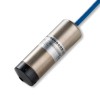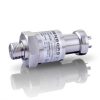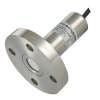Source marine-certified level transmitters for critical applications like ballast control, fuel management, and bilge monitoring. Ensures safety, compliance, and operational efficiency at sea.
Marine approved liquid level sensors are indispensable instruments designed and rigorously certified to operate reliably within the challenging conditions of ships, offshore platforms, and other maritime installations. These devices provide essential liquid level measurements, converting them into stable electrical signals for integration into vessel control, monitoring, and safety systems. Possessing certifications from recognised marine classification societies confirms their ability to withstand constant vibration, saltwater corrosion, shock, and stringent EMC requirements, ensuring dependable performance in critical applications ranging from ballast and fuel tank gauging to bilge and wastewater monitoring.
 LMK458 Marine Approved Hydrostatic Level Transmitter - Marine approved level transmitter with 4-20mA output for measuring level of contents inside ship ballast, fuel, liquid cargo or wastewater tanks
LMK458 Marine Approved Hydrostatic Level Transmitter - Marine approved level transmitter with 4-20mA output for measuring level of contents inside ship ballast, fuel, liquid cargo or wastewater tanks DMK 458 Seawater Low Range Pressure Transmitter - Sea water corrosion resistant low range pressure transmitter for marine, ship and offshore engineering.
DMK 458 Seawater Low Range Pressure Transmitter - Sea water corrosion resistant low range pressure transmitter for marine, ship and offshore engineering. LMK 487 Submersible Ballast Tank and Draught Level Pressure Transmitter - A 22mm diameter titanium body seawater depth and level probe with a 4-20mA output with Lloyds and DNV-GL ship approval, for monitoring the quantity of ballast or the draft of a ship’s hull.
LMK 487 Submersible Ballast Tank and Draught Level Pressure Transmitter - A 22mm diameter titanium body seawater depth and level probe with a 4-20mA output with Lloyds and DNV-GL ship approval, for monitoring the quantity of ballast or the draft of a ship’s hull. LMK457 Marine Approved Level Transmitter - Marine approved level transmitter with 4-20mA current loop output for shipbuilding with optional all CuNiFe construction for sea-water compatibility in ranges from 0.4 mH2O to 250mH2O gauge.
LMK457 Marine Approved Level Transmitter - Marine approved level transmitter with 4-20mA current loop output for shipbuilding with optional all CuNiFe construction for sea-water compatibility in ranges from 0.4 mH2O to 250mH2O gauge.
Find out more about Marine Approved Liquid Level Sensors to determine which product options and capabilities will best meet your application requirements.
Marine approved liquid level sensors are specifically engineered and certified to meet the demanding conditions and stringent regulatory requirements encountered in maritime environments. Obtaining certification from recognized classification societies such as DNV, ABS, Lloyd’s Register, Bureau Veritas, or RINA is paramount, signifying that the sensor has undergone rigorous testing to withstand the unique challenges of shipboard and offshore installations. These challenges include constant vibration, mechanical shock from wave impacts, exposure to corrosive saline atmospheres, wide temperature fluctuations, and stringent electromagnetic compatibility (EMC) requirements to prevent interference with sensitive navigation and communication equipment.
The necessity for marine certification stems directly from the critical nature of the applications these sensors serve and the harsh operating environment. Reliability is non-negotiable, as failures can impact vessel stability, operational efficiency, safety, and environmental compliance. Consequently, these sensors often feature robust construction, typically utilizing materials like 316L stainless steel, Duplex stainless steel, or even Titanium for wetted parts to resist corrosion from seawater, fuels, or various waste liquids. Housing designs prioritize high ingress protection ratings (e.g., IP67, IP68) to prevent water intrusion, and internal electronics are potted or conformally coated for enhanced protection against moisture and vibration.
Specific sensor technologies are selected based on the application demands within the marine context. Submersible hydrostatic pressure transmitters are commonly employed for tank gauging in ballast tanks, fuel tanks, and service tanks due to their simplicity, reliability, and ability to be installed directly within the liquid.
Integration into ship automation and control systems (e.g., Integrated Automation Systems (IAS), Alarm Monitoring Systems (AMS), Distributed Control Systems (DCS), SCADA) is facilitated through standard industrial output signals. While 4-20mA analogue outputs remain common, digital communication protocols like HART, Modbus RTU, or fieldbus options such as Profibus PA are increasingly specified for enhanced diagnostics, remote configuration, and simpler wiring architectures on complex installations. Intrinsic safety (Ex i) or explosion-proof (Ex d) certifications are often required in conjunction with marine approval for sensors installed in hazardous areas, such as fuel tanks or adjacent spaces.
Applications for marine-certified level sensors are diverse and critical for vessel operation and safety. Accurate measurement in seawater ballast tanks is essential for maintaining vessel trim, stability calculations, and managing stress on the hull. Bilge water monitoring requires robust sensors capable of handling oily water mixtures and detecting low levels to trigger pumping operations and prevent pollution. Level monitoring in tanks containing fuel (MGO, HFO, LNG) is crucial for consumption tracking, bunkering operations, and ensuring sufficient fuel reserves; high accuracy and reliability are vital here. Other key applications include monitoring levels in freshwater tanks, sewage holding tanks, greywater tanks, sludge tanks, lubricating oil tanks, and hydraulic oil reservoirs. On offshore oil and gas platforms, similar sensors are used for process vessels, storage tanks, and utility systems, facing equally harsh conditions. A specialized application involves measuring external sea level, often used to control the operation of seawater abstraction pumps for cooling systems or ballast intake, ensuring pumps only run when sufficiently submerged.
